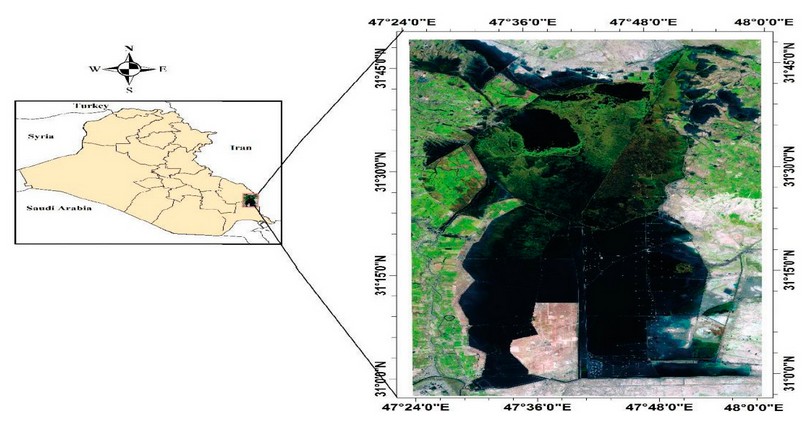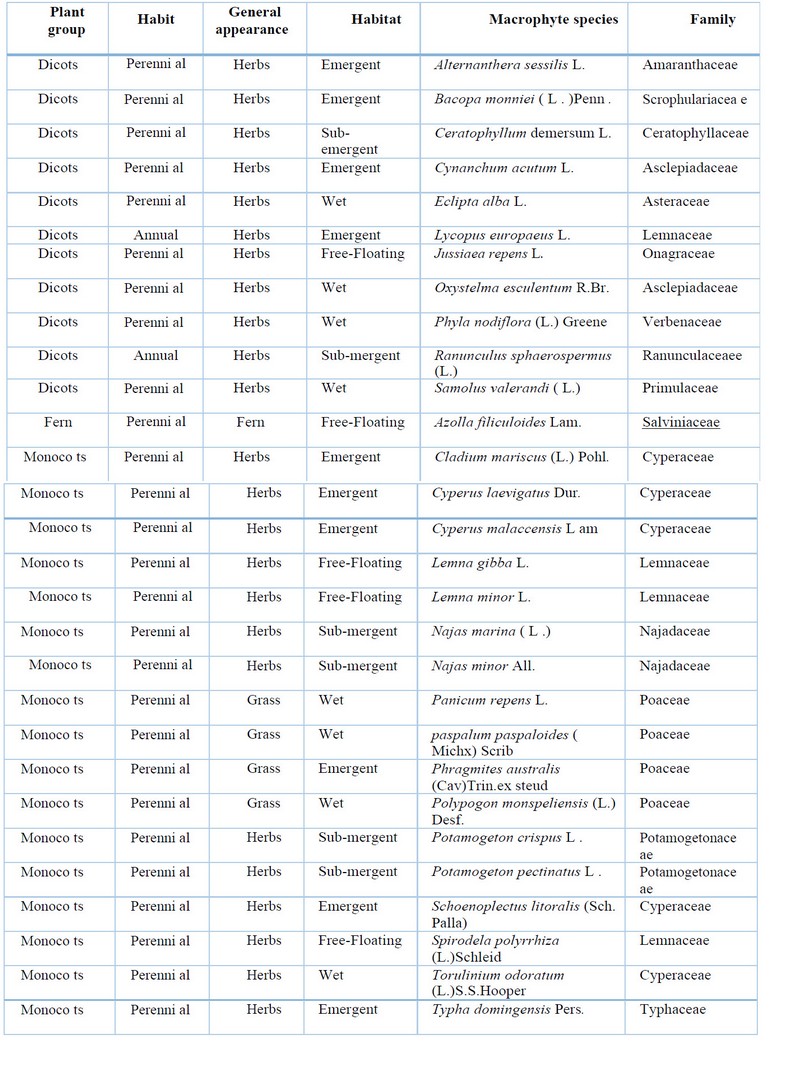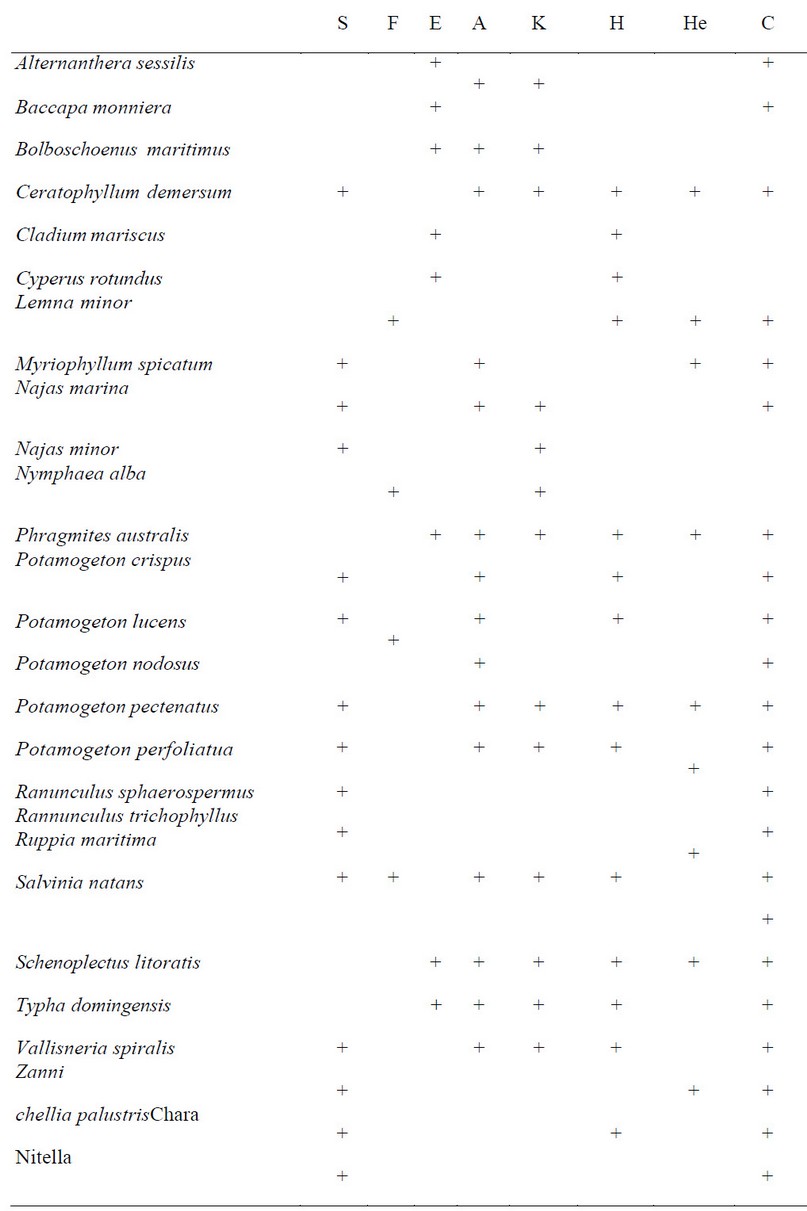2023.08.04.90
Files > Volume 8 > Vol 8 no 4 2023
Khansaa Rasheed Al-Joboury1*, Moutaz A. Al-Dabbas2
1Iraq Natural History Research Center and Museum, University of Baghdad, Iraq.
2Department of Geology, College of Science, Baghdad University, Baghdad, Iraq. [email protected].
*Correspondence: [email protected]
Available from: http://dx.doi.org/10.21931/RB/2023.08.04.90
ABSTRACT
Hawizeh Marsh symbolizes the cultural and environmental richness that characterizes Iraq, which all Iraqis take great pride in. The marshes of Hawizeh are mainly fed using the waters from the Tigris River in Iraq, with additional input from the Karkha River in Iran, and the rainstorm flows for water for the winter season are fed using the mountainous region separating Iraq and Iran. Hawizeh Marsh is a place of great beauty that has welcomed visitors for over 1000 years. It has been the refuge of globally threatened peoples and also threatened biota and remains the home of a great culture. In recent decades, the environment of this area and its economic values have been greatly threatened. These marshes also hold slowly release these waters later in the year that eventually flows south in Hawizeh for the Shat Al-Arab in the summer and fall months, also on for the Gulf.
Keywords: Geological, Plant, Diversity, Hawizeh, Iraq.
INTRODUCTION
Hawizeh Marsh lies east of the Tigris River, straddling the Iran-Iraq border. It was found that about 75- 80% is located in Iraq, and the remainder is in Iran, which is known as Hor Al-Azim and is fed primarily by the Kharkeh River1,2,3. It has been noted in Iraq that this marsh is provided by the two most critical main distributaries in the Tigris River near Amarah. Iraq is one of the most important countries that faces a real challenge in water sufficiency and quality—restoration and reflooding for drained marshes in Iraq after 2003 need to be expounded research. Al-Hawizeh Marsh is considered under the evaluation of risk assessment for heavy metals4,5. Aquatic ecosystems are affected by several health stressors which significantly deplete biodiversity. In the future, the continuous loss of biodiversity and its effects are predicted to be more significant for aquatic ecosystems than terrestrial ecosystems6,7. One of the most essential stressors is the increased pollution and inadequate consideration of environmental impacts on marine environments from industrial development, agricultural practices, and urbanization8,9. The indiscriminate release of organic and inorganic liquid wastes and airborne deposition change the physio-chemical characteristics of water, causing hazards for aquatic flora, fauna, and humans. The marshes for Hawizeh are mainly fed by the waters of the Tigris River in Iraq, with additional input from the Karkha River of Iran, and the rainstorm flows for water for the winter season are fed using the mountainous region separating Iraq and Iran10. Seasonal wetlands at the northern reaches of Hawizeh Marsh, called the Sanaf, which are highly saline due to repeating cycles for evaporation and annual drying, are enriched using these winter rain waters (Figure 1.). These marshes hold and slowly release these waters later in the year that eventually flow south through Hawizeh for the Shat Al- Arab in the summer and fall months and on for the Gulf11,12,13.

Figure 1. The study area location is based on March 2020. 14.
Heavy metals are the naturally occurring elements in the earth's crust, but uncontrolled anthropic inputs have altered the metals' natural biogeochemical cycles. Heavy metals persist in the environment long after being released into the earth's crust because they are non-degradable. Heavy metals have very toxic effects on microorganisms, animals, plants, and humans, and their contamination of the environment has become one of the most significant environmental issues. Most heavy metals include cobalt (Co), iron (Fe), copper (Cu), zinc (Zn), and manganese (Mn). Also, they are crucial to the metabolic activity of biota at low concentrations and are considered micronutrients or essential elements. Heavy metals enter the aquatic environment from anthropogenic and natural sources, classified throughout various marine environmental compartments (water, suspended solids, sediments, and biota) and can lead to harmful effects that may be acutely or chronically toxic for aquatic life in the affected area. Many studies have shown that aquatic plants are sinks of heavy metals in marine ecosystems. Generally, factors such as the stage for plant growth and characteristics of the metals themselves affect absorption rates and accumulation in plant species and aquatic flora15.
Ecosystem plants
Ecosystem plants are affected by a variety of factors, physical and chemical, which have negative or positive impacts on the production and growth of plants because temperature plays an essential role in many.
Physico-chemical and biological processes because of the effects on gas melting, salinity, and susceptibility. The spatial differences in water temperature between sites are due to changes at the sampling period in each site or may be due to changes in water depth in each site. The temperature for Al-Hawizeh marsh depends to a large extent on the ambient temperature. The study showed there was a very difference in the water temperature during the months of the year because the summer months were marked by the high temperature of the water and its decrease in the cold months. The water temperatures increase evaporation rates, resulting in continuous water levels declining at the Tigris and Euphrates Rivers flowing in Turkey and Syria and from the Iranian Al-Karkha River, Al-Mashara h, and Al-Kahla Rivers to the marsh. This situation impacts water depth and transparency. High evaporation reduces the dissolved oxygen, increasing stress and increasing the salt content of many aquatic species16.
Habitat Types
There have been many efforts to characterize the habitats for the marshes in Iraq. Scott (1994), for example, recognized eight major wetland types at the Mesopotamian marshes, including Hawizeh Marsh. The types are A: Permanent freshwater lakes and a rich submerged growth for aquatic vegetation, typically with a marginal zone for floating aquatic vegetation.
B: Permanent freshwater marshes dominated by tall stands for Phragmites, Typha and Cyperus.
C: Streams, Rivers, canals and irrigation channels, little emergent vegetation and steep earth or muddy banks. D: Man-made irrigation ponds, permanent ponds, and duck-hunting ponds Also pronounced drawdown in summer and little emergent vegetation.
E: Seasonal freshwater marshes are dominated by rushes and sedges, occurring like a broad belt around the edge of the permanent marshes.
F: Semi-desert steppe and seasonally flooded mudflats. G: Seasonally flooded arable land and Irrigated land.
H: Shallow, brackish for saline lagoons, primarily seasonal and extensive areas for Salicornia sp17.
Plant diversity
Thirty species of aquatic plants belonging to 25 genera were recorded at many studied stations with Al- Huwaizah marsh during the present study. Registered species belonging to 16 families, headed by Cyperaceae for 6 species forming 20%; Lemnaceae and Gramineae (Poaceae) families for 4 species forming 13.33% of each family, Asclepiadaceae; Najadaceae and Potamogetonaceae families for 2 species with 6.66% for each family, whereas the remaining families which have only 1 species by 3.33% for each family, respectively. All species related to flowering plants (Angiospermae) (Table 1).

Table 1. List families and macrophyte species according to habitat, general appearance, habit, and plant group in Al- Al-Al-Huwaizah Marsh18.

Table 2. List of aquatic plants collected in 2004-2005 from the reflooded marshes19.
Inventory and distribution
A total of 104 aquatic and semi-aquatic plants were recorded in Iraq. The diversity and habitat for these taxa show 96 vascular plants, 92 flowering plants, and 4 pteridophytes (Ferns). The highest number of aquatic plant species historically recorded at the southern marshes was 44 at the central marshes, and the lowest number of species was 23 at Al-Kirmatia. The highest percentage for recovery is 56.5% at Kirmatia and 50% at Central Marshes, but the lowest percentage is 19 in Hewaizah. The aquatic plants collated in 2004- 2005 from the marshlands for Iraq with their habitat and distribution, and only 27 species of typical marine plants were collected. This represents only 29% of the total number of the previously recorded species in Iraq. Twenty-three aquatic species have lost or not appeared until now. Typha domingensis (cattail), Phragmites australis (Reed), and Schonemoplectus litoralis (Sedege) are the central communities that very quickly re-established and dominated the whole reflooded marshes for southern Iraq. Their cover and density vary from the marsh to the marsh. Phragmites australis grows very densely and covers vast areas, making it the dominant community. Still, the other two species, Schoeno-plexus litoralis and Typha domingensis, are rare, or Schoenoplctus were absent at Al-Hewaizah. At Al-Hammar (Barga and Nagara), Schoenoplectus and Typha domingensis are the dominant communities, but the Reed is less frequent, rare, or sometimes absent. The three communities at Abozerig and Kirmatia are physiognomically distinct and very obvious at different stations. Other vascular plants like Limna minor, Ceratophyllum demersum, Salinia natans, and Paspalum paspaloides occur in different places (Table 2).
CONCLUSIONS
The current extension for Hawizeh Marsh covers 75% of the original size of the wetland. If it does not interfere with other present and proposed future land uses, it would allow for implementing some agri-cultural development plans. It would remain flexible concerning the final selection of marsh restoration areas to maximize productive field irrigation, petroleum, and other natural resource development opportunities.
Author Contributions: Conceptualization, X.X. and Y.Y.; methodology, X.X.; software, X.X.; validation, Y.Y.; formal analysis, X.X. and Y.Y.; investigation, X.X.; resources, X.X.; data curation, X.X. and Y.Y.; writing—original draft preparation, X.X.; writing—review and editing, X.X.; visualization, X.X.; supervision, X.X.; project administration, X.X.; funding acquisition, Y.Y.
Funding: "This research received no external funding".
Institutional Review Board Statement: "Not applicable."
Informed Consent Statement: "Not applicable."
Acknowledgments: We thank all the researchers who helped us reach the study areas and served as scientific guides on field trips.
Conflicts of Interest: "The authors declare no conflict of interest."
REFERENCES
1. Hashim S J, Borisovna VK, Schamilevich, D. R. The International Legal Status of Marshes of Iraq as Protected Natural Areas. Academic Journal of Interdisciplinary Studies. 2019; 8(4), 197-201.
2. Rubec C. A wetland future for Iraq. Marsh Bulletin. 2013; 8(2), 114-130.
3. Albarakat R., Lakshmi V, Tucker CJ. Using Satellite Remote Sensing to Study the Impact of Climate and Anthropogenic Changes in the Mesopotamian Marshlands, Iraq. Remote Sensing.2018; 10:1524.
4. Romano L. The Mesopotamian Marshlands (AlAhwār) in the Past and To Day. [in:] Collins P. (ed.), Basra: Its History, Culture, and Heritage: Proceedings of the Conference Celebrating the Opening of the Basrah Museum, September 28–29, 2016, British Institute for the Study of Iraq. 2019: 7–12.
5. Rubec C, Alwash , Bachmann A. The critical biodiversity areas project in Iraq: objectives and scope 2004-2008. BioRisk. 2009; 3: 39-53.
6. Harguinteguy CA,Cirelli AF, PignataML. Heavy metal accumulation in aquatic plant Stuckenia filiformis leaves and its relationship with sediment and water in the Suquía River (Argentina). MicrochemJ. 2014; 114:111-118
7. UNESCO: The Ahwar of Southern Iraq: Refuge of Biodiversity and the Relict Landscape of the Mesopotamian Cities.2016: 1481.
8. Richardson C.J., Reiss P., Hussain N.A., Alwash A.J., Pool D.J.: The restoration potential of the Mesopotamian marshes of Iraq. Science, vol. 307, issue 5713, 2005, pp. 1307–1311.
9. Hussein ZE, Hasan RH, Aziz NA. Detecting the Changes of AL-Haw- izeh Marshland and Surrounding Areas Using GIS and Remote Sensing Techniques. Association of Arab Universities Journal of Engineering Sciences.2018; 25(1): 53–63.
10. Al‐Mudaffar FN, Goodwin KP, Mahdi BA, Stevens ML. Effects of Mesopo- tamian Marsh (Iraq) desiccation on the cultural knowledge and livelihood of Marsh Arab women. Ecosystem Health and Sustainability. 2016; 2(3):1207.
11. Al-Abbawy, DA H, Al-Mayah AA. Ecological survey of aquatic macrophytes in restored marshes of southern Iraq during 2006 and 2007. Marsh Bulletin. 2010; 5(2), 177-196.
12. Al-Haidarey MJS, Hassan FM, Al-Kubaisey ARA, Douabul AaZ. The geoaccumulation index of some heavy metals in Al-Hawizeh Marsh, Iraq. E-J Chem. 2010.
13. Bai L, Liu XL, Hu J, Li J, Wang ZL, Han G, Li SL, Liu CQ. Heavy Metal Accumulation in Common Aquatic Plants in Rivers and Lakes in the Taihu Basin. Intl J Environ Res and Public Health.2018.
14. Aziz, NA, Alwan IA. An accuracy analysis comparison of supervised classification methods for mapping land cover using sentinel 2 images in the Al-Hawizeh marsh area, southern Iraq. Geomatics and Environmental Engineering, 2021;15(1): 5-21.
15. Al-Abbawy, D A, AL-THAHAIBAWI, B M H, AL-MAYALY, I K, YOUNIS, K H Assessment of some heavy metals in various aquatic plants of Al-Hawizeh Marsh, southern of Iraq. Biodiversitas journal of biological diversity.2021; 22(1).
16. Al-Thahaibawi, BMH, Al-Abbawy, DAH, Al-Mayaly, IKA, and Younis, KH. The effect of some environmental variables on the abundance and distribution of aquatic macrophytes in Al-Hawizeh marsh, Iraq. In IOP Conference Series: Earth and Environmental Science. 2021; 722(1): 2001.
17. Rubec C. Management Plan for the Hawizeh Marsh Ramsar Site of Iraq Second Draft. Volume 1: Background, Vision, Principles and Annexes. Iraq National Marshes and Wetlands Committee. 2008: 1-75.
18. Al-Thahaibawi BMH, Al-Mayaly IK, Younis, KH Ecological survey of aquatic macrophytes in Al- Huwaizah marsh southern of Iraq after inclusion in the world heritage list. Plant Archives. 2019; 19(2), 294- 302.
19. Alwan ARA. Past and present status of the aquatic plants of the Marshlands of Iraq. J. Marsh Bull. 2006;1(2):120-172.
20. Al-Ashbal, H.N., Al-Essa, R.A., Al-Saffar, H.H. 2023. Survey of Histeridae Beetles with Forensic Important in Kerbela Province-Iraq; 2414 (1).
Received: 28 September 2023/ Accepted: 15 November 2023 / Published:15 December 2023
Citation: Al-Joboury K. R., Al-Dabbas M. A. Geological and Plant Diversity in Hawizeh Marshes, Iraq. Revis Bionatura 2023;8 (4) 90. http://dx.doi.org/10.21931/RB/2023.08.04.90
Peer review information. Bionatura thanks anonymous reviewer(s) for their contribution to the peer review of this work using https://reviewerlocator.webofscience.com/
All articles published by Bionatura Journal are made freely and permanently accessible online immediately upon publication, without subscription charges or registration barriers.
Bionatura ISSN. 13909355. Scopus coverage years: from 2016 to the Present
Publisher's Note: Bionatura stays neutral concerning jurisdictional claims in published maps and institutional affiliations.
Copyright: © 2023 by the authors. They were submitted for possible open-access publication under the terms and conditions of the Creative Commons Attribution (CC BY) license (https://creativecommons.org/licenses/by/4.0/).
